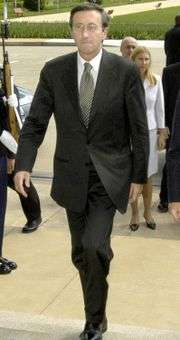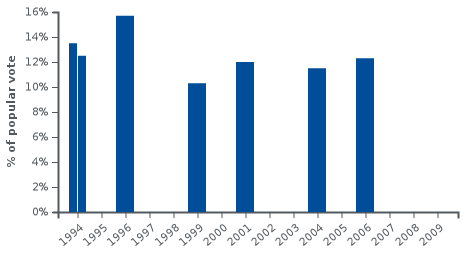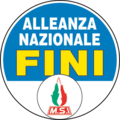National Alliance (Italy)
National Alliance (Italian: Alleanza Nazionale, AN) was a conservative[5][6][7][8] political party in Italy.
National Alliance Alleanza Nazionale | |
|---|---|
 | |
| President | Gianfranco Fini (1995–2008) Ignazio La Russa (acting, 2008–2009) |
| Founded | 27 January 1995 |
| Dissolved | 22 March 2009 |
| Preceded by | Italian Social Movement[1] |
| Merged into | The People of Freedom |
| Newspaper | Secolo d'Italia |
| Membership (2004) | 250,000[2] |
| Ideology | Conservatism[3] National conservatism[4] |
| Political position | Right-wing[1] |
| National affiliation | Pole of Good Government (1994) Pole for Freedoms (1996–2001) House of Freedoms (2001–2008) |
| European affiliation | Alliance for Europe of the Nations |
| European Parliament group | Union for Europe of the Nations |
AN was the successor of the post-fascist Italian Social Movement (MSI), which had moderated its policies over its last decades and finally distanced itself from its former ideology during a convention in Fiuggi by dissolving into the new party in 1995.[9][10]
Gianfranco Fini was the leader of AN from its foundation through 2008, after being elected President of the Chamber of Deputies. Fini was succeeded by Ignazio La Russa, who managed the merger of the party with Forza Italia (FI) into The People of Freedom (PdL) in 2009. A group of former AN members, led by La Russa, left FI in 2012 in order to launch the Brothers of Italy (FdI), while others remained in the PdL and were among the founding members of the new Forza Italia (FI) in 2013.
History
Foundation
National Alliance, launched in 1994, was officially founded in January 1995, when the Italian Social Movement (MSI), the former neo-fascist party, merged with conservative elements of the former Christian Democracy, which had disbanded in 1994 after two years of scandals and various splits due to corruption at its highest levels, exposed by the Mani pulite investigation, and the Italian Liberal Party, disbanded in the same year. Former MSI members were however still the bulk of the new party and former MSI leader Gianfranco Fini was elected leader of the new party.
The AN logo followed a template very similar to that of the Democratic Party of the Left, with the logo of the direct predecessor party in a small circle, as a means of legally preventing others from using it. The name was suggested by an article on the Italian newspaper Il Tempo written in 1992 by Domenico Fisichella, a prominent conservative academic. Starting in the 1990s, the MSI gradually transformed into a mainstream right-wing party, culminating in its 1995 dissolution into AN.
Government participation

The party was part of all three House of Freedoms coalition governments led by Silvio Berlusconi. Gianfranco Fini was nominated Deputy Prime Minister after the 2001 general election and was Foreign Minister from November 2004 to May 2006.
When Gianfranco Fini visited Israel in late November 2003 in the function of Italian Deputy Prime Minister, he labeled the racial laws issued by the fascist regime in 1938 as "infamous", as also Giorgio Almirante, historic leader of MSI, had done before.[11] He also referred to the Italian Social Republic as belonging to the most shameful pages of the past, and considered fascism part of an era of "absolute evil", something which was hardly acceptable to the few remaining hardliners of the party. As a result, Alessandra Mussolini, the granddaughter of the former fascist dictator Benito Mussolini, who had been at odds with the party on a number of issues for a long time, and some hardliners left the party and formed Social Action.[7][12]
In occasion of the 2006 general election, AN ran within the House of Freedoms, with new allies. The centre-right lost by 24,000 votes in favour of the centre-left coalition The Union. Individually AN received nearly 5 million votes, amounting to 12.3%. In July 2007 a group of splinters led by Francesco Storace formed The Right, which was officially founded on 10 November. Seven MPs of AN, including Teodoro Buontempo and Daniela Santanchè, joined the new party.
The People of Freedom
In November 2007 Silvio Berlusconi announced that Forza Italia would have soon merged or transformed into The People of Freedom (PdL) party.[13][14][15]
After the sudden fall of the second Prodi government in January 2008, the breakup of The Union and the subsequent political crisis which led to a fresh general election, Berlusconi hinted that Forza Italia would have probably contested its last election and the new party would have been officially founded only after that election. In an atmosphere of reconciliation with Gianfranco Fini, Berlusconi also stated that the new party could see the participation of other parties.[16] Finally, on 8 February, Berlusconi and Fini agreed to form a joint list under the banner of the "People of Freedom", allied with the Northern League (LN).[17] After the victory of the PdL in the 2008 general election, AN was merged into the PdL in early 2009.[18]
Ideology
National Alliance's political programme emphasized:
- traditional values, being often close to the position of the Catholic Church, despite some social liberal and secular attitudes;
- law and order, especially laws aimed at controlling immigration and implementing punishment;
- support for Israel,[12] the United States and European integration;[19]
- prohibition of all drugs, including marijuana.
Distinguishing itself from the MSI, the party distanced itself from Benito Mussolini and Fascism and made efforts to improve relations with Jewish groups.[7] For example, after far-right skinheads celebrated the then-AN politician Gianni Alemanno's election as Mayor of Rome in 2008 by making the Roman salute outside the Palazzo Senatorio, Alemanno visited Rome Synagogue, where he gave a speech praising the "universal" values of the fight against Nazism. The shift was also present in the rhetoric of the party's leader Fini, who went from declaring himself as "fascist for the 2000s" in 1987 when at the head of the MSI, to describing himself as a "conservative" at the time of the AN's launch in 1994.[19] With most hardliners leaving the party,[7][12] it sought to present itself as a respectable conservative party and to join forces with Forza Italia in the European People's Party and, eventually, in a united party of the centre-right. Historian David Broder has compared the AN to Spain's post-Franco People's Party.[19]
Although the party approved the market economy and held favourable views on liberalizations and the privatization of state industries, however AN was to the left of Forza Italia on economic issues and sometimes supported statist policies.[20] That is why the party was strong in Rome and Lazio, where most civil servants live. The implosion of the Christian Democrats created space for a more economically interventionist party of the conservative right, and the AN sought closer ties to the former DC factions which joined the Berlusconi-led alliances of the right. As part of this it also moderated its stances on the European Union and immigration, both of were conditionally accepted by the party's leadership.[19] Moreover, AN presented itself as a party promoting national cohesion, national identity and patriotism.
Regarding institutional reforms, the party was a long-time supporter of presidentialism and a plurality voting system, and came to support also federalism and to fully accept the alliance with the Northern League, although the relations with that party were tense at times, especially about issues regarding national unity.
Gianfranco Fini, a moderniser who saw Nicolas Sarkozy and David Cameron as role-models, impressed an ambitious political line to the party, combining the pillars of conservative ideology like security, family values and patriotism with a progressive approach in other areas such as stem cell research and supporting voting rights for legal aliens. Some of these positions were not shared by many members of the party, most of whom staunchly opposed stem cell research and artificial insemination.[12]
Factions
National Alliance was a heterogeneous political party and within it members were divided in different factions, some of them very organized:
- Protagonist Right (Destra Protagonista), headed by Maurizio Gasparri and Ignazio La Russa, was the bigger faction and the closest to Forza Italia, due to its liberal-conservative stances.
- New Alliance (Nuova Alleanza), formerly called Right and Freedom (Destra e Libertà), headed by Altero Matteoli and Adolfo Urso, was formed by the staunchest supporters of Gianfranco Fini within the party and supported a liberal political agenda.
- Social Right (Destra Sociale), led by Gianni Alemanno, advocated a more "social" approach to economic policy and was considered at the right of the party. It had close ties with the General Labour Union.
- D-Destra, led by Francesco Storace, was the most conservative component of the party, proud of the MSI's tradition and in open opposition to Fini. Formed as a split from the Social Right, in July 2007 the group finally left AN and launched The Right.
- Christian Reformists (Cristiano Riformisti) was a minor Christian democratic faction.
In the party there was also a group named Ethic-Religious Council, whose board members included Gaetano Rebecchini (founder, ex-DC), Riccardo Pedrizzi (president), Franco Tofoni (vice president), Luigi Gagliardi (secretary-general), Alfredo Mantovano, Antonio Mazzocchi and Riccardo Migliori. This was not a faction but an official organism within the party and expressed the official position of the party on ethical and religious matters. Sometimes the group criticized Gianfranco Fini for his liberal views on abortion, artificial insemination and stem-cell research, which led some notable ex-DC members as Publio Fiori to leave the party. Some members of the council, such as Pedrizzi and Mantovano were described as members of an unofficial Catholic Right faction.
Popular support
The party had roughly 10–15% support across Italy, having its strongholds in Central and Southern Italy (Lazio 18.6%, Umbria 15.2%, Marche 14.3%, Abruzzo 14.3%, Apulia 13.2%, Sardinia 12.9%, Tuscany 12.6% and Campania 12.6% in the last general election), scoring badly in Lombardy (10.2%) and Sicily (10.9%), while competing in the North-East (Friuli-Venezia Giulia 15.5% and Veneto 11.3%).
The party had a good showing in the first general election to which it took part (13.5% in 1994) and reached 15.7% in 1996, when Fini tried for the first time to replace Silvio Berlusconi as leader of the centre-right. From that moment the party suffered an electoral decline, but remained the third force of Italian politics.
In the 2006 general election, the final election to which the party participated with its own list, AN won 12.3% of the vote, securing 71 seats in the Chamber of Deputies and 41 in the Senate. In the 2008 general election the party had 90 deputies[21] and 48 senators[22] elected. The electoral results of National Alliance in general (Chamber of Deputies) and European Parliament elections since 1994 are shown in the chart below.

The electoral results of National Alliance in the 10 most populated regions of Italy are shown in the table below.
| 1994 general | 1995 regional | 1996 general | 1999 European | 2000 regional | 2001 general | 2004 European | 2005 regional | 2006 general | |
| Piedmont | 8.3 | 11.2 | 12.1 | 7.5 | 11.9 | 9.2 | 8.8 | 9.5 | 11.8 |
| Lombardy | 5.8 | 10.0 | 9.0 | 6.0 | 9.7 | 8.6 | 7.2 | 8.7 | 10.2 |
| Veneto | 7.7 | 10.7 | 11.7 | 8.3 | 9.8 | 8.5 | 9.0 | 8.1 | 11.3 |
| Emilia-Romagna | 9.0 | 10.3 | 11.5 | 8.6 | 11.4 | 9.7 | 8.4 | 8.9 | 10.2 |
| Tuscany | 10.9 | 13.1 | 15.8 | 10.9 | 14.9 | 13.0 | 10.9 | 10.9 | 12.6 |
| Lazio | 25.3 | 24.5 | 28.9 | 20.3 | 23.1 | 20.4 | 18.4 | 23.9[23] | 18.6 |
| Campania | 20.3 | 18.3 | 18.7 | 10.7 | 11.2 | 13.1 | 13.2 | 10.6 | 12.6 |
| Apulia | 27.5[24] | 20.4 | 17.9 | 12.7 | 15.5 | 15.3 | 16.0 | 12.1 | 13.2 |
| Calabria | 17.2 | 16.3 | 23.4 | 10.2 | 10.4 | 15.2 | 15.5 | 9.9 | 11.0 |
| Sicily | 14.0 | 14.1 (1996) | 16.4 | 12.1 | 11.3 (2001) | 10.7 | 14.5 | 10.6 (2006) | 10.9 |
| ITALY | 13.5 | - | 15.7 | 10.3 | - | 12.0 | 11.3 | - | 12.3 |
Election results
Italian Parliament
| Chamber of Deputies | |||||
| Election year | Votes | % | Seats | +/– | Leader |
|---|---|---|---|---|---|
| 1994 | 5,214,133 (3rd) | 13.5 | 109 / 630 |
||
| 1996 | 5,870,491 (3rd) | 15.7 | 93 / 630 |
||
| 2001 | 4,463,205 (5th) | 12.0 | 99 / 630 |
||
| 2006 | 4,706,654 (3rd) | 12.3 | 71 / 630 |
||
| Senate of the Republic | |||||
| Election year | Votes | % | Seats | +/– | Leader |
|---|---|---|---|---|---|
| 1994 | with PBG | – | 48 / 315 |
||
| 1996 | with PpL | – | 43 / 315 |
||
| 2001 | with CdL | – | 45 / 315 |
||
| 2006 | 4,234,693 (#3) | 12.2 | 41 / 315 |
||
European Parliament
| European Parliament | |||||
| Election year | Votes | % | Seats | +/– | Leader |
|---|---|---|---|---|---|
| 1994 | 4,108,670 (3rd) | 12.5 | 11 / 87 |
||
| 1999 | 3,202,895 (3rd) | 10.3 | 9 / 87 |
||
| 2004 | 3,736,606 (3rd) | 11.5 | 9 / 78 |
||
Leadership
- President: Gianfranco Fini (1995–2008), Ignazio La Russa (acting, 2008–2009)
- Coordinator: Maurizio Gasparri (1995–1998), Ignazio La Russa (2003–2005)
- Spokesman: Francesco Storace (1995–1997), Adolfo Urso (1997–2001), Antonio Landolfi (2001–2005), Andrea Ronchi (2005–2009)
- Head of Political Secretariat: Donato Lamorte (1995–2002), Andrea Ronchi (2002–2004), Carmelo Briguglio (2002–2004), Donato Lamorte (2004–2009)
- President of National Assembly: Domenico Fisichella (1995–2005), Marcello Perina (2005–2006), Francesco Servello (2006–2009)
- Organizational Coordinator: Giuseppe Tatarella (1995–1998), Altero Matteoli (1998–2002), Donato Lamorte (2002–2004), Italo Bocchino (2004–2005), Marco Martinelli (2005–2009)
- Administrative Secretary: Francesco Pontone (1995–2009)
- Party Leader at the Chamber of Deputies: Raffaele Valensise (1994–1995), Giuseppe Tatarella (1995–1998), Gustavo Selva (1998–2001), Ignazio La Russa (2001–2003), Gian Franco Anedda (2003–2004), Ignazio La Russa (2004–2008), Italo Bocchino (deputy-leader of PdL's group, 2008–2009)
- Party Leader at the Senate: Giulio Maceratini (1994–2001), Domenico Nania (2001–2006), Altero Matteoli (2006–2008), Maurizio Gasparri (leader of PdL's group, 2008–2009)
- Party Leader at the European Parliament: Cristiana Muscardini (1994–2004), Roberta Angelilli (2004–2009)
Symbols
 1995–2009
1995–2009
External links
References
- Ruzza, Carlo; Fella, Stefano (2009), Re-inventing the Italian right: Territorial politics, populism and 'post-fascism', Routledge, p. 1, ISBN 9780415344616
- "Archived copy". Archived from the original on 10 November 2013. Retrieved 10 November 2013.CS1 maint: archived copy as title (link)
- Mareš, Miroslav (2006), Transnational Networks of Extreme Right Parties in East Central Europe: Stimuli and Limits of Cross-Border Cooperation (PDF), p. 4, archived from the original (PDF) on 18 August 2011
- Tarchi, Marco (2007), "Recalcitrant Allies: The Conflicting Foreign Policy Agenda of the Alleanza Nazionale and the Lega Nord", Europe for the Europeans, Ashgate, p. 188
- Chiara Moroni, Da Forza Italia al Popolo della Libertà, Carocci, Roma 2008, pp. 75-77
- Oreste Massari, I partiti politici nelle democrazie contemporanee, Laterza, Roma-Bari 2004, p. 90
- Luciano Bardi - Piero Ignazi - Oreste Massari, I partiti italiani, Egea 2007, pp. 151, 173n.
- Slomp, Hans (2011). Europe, A Political Profile: An American Companion to European Politics: An American Companion to European Politics. ABC-CLIO. p. 407. ISBN 978-0-313-39181-1.
- Catellani, Patrizia; Milesi, Patrizia; Crescentini, Alberto (2006). One root, different branches: Identity, injustice and schisms. Extreme Right Activists in Europe: Through the Magnifying Glass. Routledge. p. 204.
- Moliterno, Gino, ed. (2002). "National alliance". Encyclopedia of Contemporary Italian Culture. Routledge. p. 562.
- Il Domenicale
- Piero Ignazi, Partiti politici in Italia, Il Mulino, Bologna 2008, pp. 27-31.
- Sky tg24 - Tutte le notizie in formato video Archived 15 June 2009 at the Wayback Machine
- «Oggi nasce il partito del popolo italiano». Corriere della Sera
- Archived 17 December 2007 at the Wayback Machine
- «Via l'Ici e stretta sulle intercettazioni» Corriere della Sera
- Svolta di Berlusconi, arriva il Pdl: "Forza Italia-An sotto stesso simbolo" - LASTAMPA.it
- Mussolini's heirs merge with Silvio Berlusconi's Forza Italia party The Telegraph. 23 March 2009
- Broder, David (17 July 2020). "The Rise of Italy's Populist Right Is a Bleak Warning From the Recent Past". Jacobin (magazine). Retrieved 18 July 2020.
- Agnew, John (February 1997). "The dramaturgy of horizons: geographical scale in the 'Reconstruction of Italy' by the new Italian political parties, 1992–1995". Political Geography. Elsevier. 16 (2): 99–121. doi:10.1016/s0962-6298(96)00046-7.CS1 maint: ref=harv (link)
- Excluding Fiamma Nirenstein, Alessandro Ruben and Souad Sbai, whose election was supported both by Forza Italia and National Alliance, http://download.alleanzanazionale.it/Elezioni2008/DeputatiPDLinXVIlegislatura.pdf Archived 1 October 2008 at the Wayback Machine
- Archived 21 November 2011 at the Wayback Machine
- Combined result of National Alliance (16.9%) and Lista Storace (7.0%), personal list of AN regional leader Francesco Storace.
- Forza Italia failed to present a list and thus most centre-right voters voted for National Alliance.
